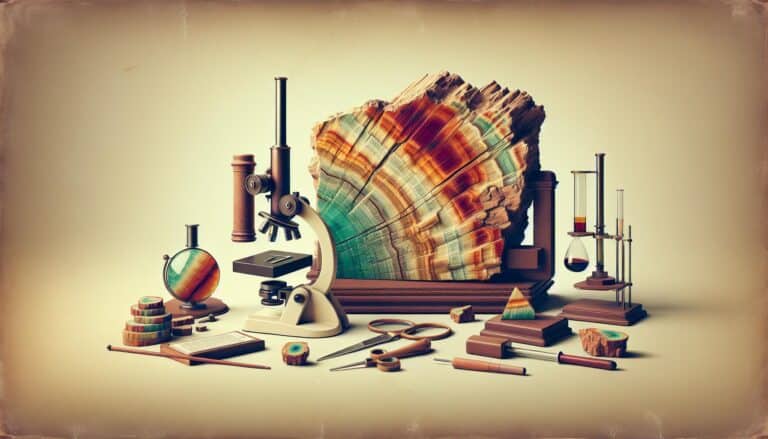Identifying hematite, a common iron oxide mineral, is easier than you might think.
It’s known for its shiny, metallic luster and its rust-red streak, which are dead giveaways for this sought-after stone. Whether you’re a rock enthusiast or just curious about the minerals you come across, knowing how to spot hematite is a handy skill.
You’ll find hematite in a variety of environments, from sedimentary rocks to volcanic settings. Its strong magnetic properties, along with its weight and hardness, set it apart from similar minerals.
With a few simple tips, you’ll be picking out hematite like a pro in no time.
To identify hematite, look for its metallic sheen and brass-yellow color, often with a greenish or blackish streak. Pyrite forms in cubic or framboidal shapes, distinguishing it from gold. It’s harder than gold, ranking about 6-6.5 on the Mohs scale.
How to Identify Hematite Through Testing
When you’ve got a shiny, metallic-looking mineral in your hands, you might suspect it’s hematite. But to be sure, you’ll need to conduct a few tests. These methods will boost your confidence in identifying hematite with precision.
Visual Inspection
Start by giving the sample a thorough visual exam. Look for a metallic luster and a red to silver-gray appearance. Hematite is also typically heavier than other stones of the same size. Keep an eye out for high density and a smooth to bumpy texture.
The Streak Test
One definitive test for hematite is the streak test. Take your sample and rub it across an unglazed ceramic tile. Unlike its darker exterior, hematite leaves a rust-red to reddish-brown streak. This is a telltale sign you’re dealing with hematite.
Magnet Test
Hematite is known for its magnetic properties. Use a magnet to see if your sample is attracted to it. Be aware that not all hematite will strongly attract a magnet since it depends on the iron content within.
Hardness Test
Perform a hardness test by scratching your specimen with a substance of known hardness. Hematite ranks around 5 to 6 on the Mohs hardness scale. If your mineral scratches glass (which ranks at 5.5), it could well be hematite.
Birefringence Test
Examine your stone under polarized light and look for birefringence – a unique feature where minerals show different colors or varying intensities of light when viewed from different angles. Hematite typically lacks this feature, so absence of it can support your identification.
Checking The Diaphaneity
Assess how light passes through the mineral. Hematite ranges from opaque to subtranslucent. If no light passes through, you’re on the right track. If the light does pass through, you might want to consider other minerals.
Single or Double Refraction
Most minerals either refract light once (single refraction) or split it into two paths (double refraction). Hematite has single refraction, which means that it will not split light into two rays.
Refractive Index Test
Using a refractometer, measure the refractive index of the mineral. Hematite’s refractive index is relatively high, typically between 2.94 and 3.22. Identifying the correct range can help confirm the presence of hematite.
Finding The Specific Gravity
Hematite’s specific gravity is another distinctive feature. To measure it, weigh your sample in air and then weigh it suspended in water. Calculate using the formula SG = Weight in Air / (Weight in Air – Weight in Water). The expected range for hematite is about 4.9 to 5.3.
Identifying Hematite in the Field
When you’re out in the field, remember to look for the typical environments where hematite can be found. Check areas of sedimentary rocks or near old volcanic settings. Recognizing the typical landscape can aid in the search for hematite.
Recognizing Potential Hematite Rocks
Any rock that seems unusually heavy, with a metallic sheen and a red streak, could be a good candidate. Also, note the rock formations and surrounding minerals; hematite often associates with quartz and other iron minerals. Look out for these co-existing minerals to bolster your identification process.
Physical Characteristics of Hematite

Hematite is distinct in its physical properties, which can help you distinguish it from other minerals. One of the most prominent features is its metallic sheen, giving it an almost mirror-like finish that can catch your eye when you’re scanning the ground for samples.
Moreover, hematite typically exhibits a high density relative to its size. When you hold a piece in your hand, it feels heavier than it looks, which is a telltale sign of this iron oxide’s presence. Its texture can range from smooth to a bumpy, almost earthy feel, indicating that it’s not just the appearance but also the touch that’s central in identifying hematite.
Magnetism and Hardness
While not as magnetic as magnetite, hematite does have a weak magnetic response due to the presence of iron. You might notice this when using a magnet test. More convincing is the hardness test where hematite can scratch glass surfaces. This characteristic is a clear indicator of hematite and can easily differentiate it from softer look-alikes.
Hematite’s crystal structure also contributes to its identification. It crystallizes in the rhombohedral lattice system and may sometimes appear in tabular or even micaceous forms. These forms can be quite striking and are another visual clue that can guide you to a proper identification.
When assessing a suspected hematite sample, analyze these physical properties carefully. Texture, density, and hardness are key aspects that will aid in your quest to accurately identify hematite among other minerals.
How Are Hematite Formed?
Hematite, one of the most abundant minerals on Earth, originates through a fascinating process that geologists have studied extensively. Iron oxide, the primary constituent of hematite, forms when iron is exposed to oxygen and water. Over vast spans of time, this reaction leads to the creation of hematite deposits, particularly in environments where water is or was present, such as lakes and deep-sea vents.
There are generally two types of hematite deposits: Banded Iron Formations (BIFs) and secondary enrichment deposits. BIFs are ancient and date back to the Precambrian Era, evidencing the oxygenation of Earth’s atmosphere. You’ll find these primarily in regions with old geological formations, such as Western Australia and the Lake Superior region of North America.
Secondary enrichment deposits, on the other hand, form closer to the Earth’s surface where groundwater leaches iron from rocks and deposits it in layers, usually in association with other minerals such as quartz.
The presence of hematite can also result from volcanic activity. When lava cools down, the iron within it oxidizes, leaving behind hematite crystals.
Understanding hematite’s origins will help you appreciate the geological history that led to its formation. Remember, hematite’s dense and iron-rich composition is a direct result of the specific conditions under which it formed. These deposits are not only studied for their beauty and usefulness but they also provide geologists with clues about the Earth’s ancient environments and climatic conditions.
Preparation for Hematite Hunting
Before embarking on your quest to find hematite, it’s crucial to prepare adequately. Knowing what tools to bring and how to stay safe will ensure a successful and enjoyable hematite hunting expedition.
Gathering the Right Tools
To properly identify hematite in the field, you’ll need a set of specific tools that aid in examination and collection. These include:
- Magnifying Glass: Essential for a closer look at the mineral’s texture and structure.
- Field Guide: Having a good field guide on minerals can help you compare your findings with professional photographs and descriptions on the spot.
- Magnet: A handy tool to check for magnetic properties.
- Streak Plate: A piece of unglazed porcelain tile to test the streak color of the mineral.
- Geologist’s Hammer: To carefully extract samples.
- Chisel and Goggles: For breaking rocks while protecting your eyes from flying fragments.
- Handheld GPS or Map: To navigate and mark locations where hematite is found.
- Sample Bags and Labels: To store and organize your finds.
Remember to only bring tools necessary for identification, as carrying excess gear can be cumbersome.
Safety Considerations
Your safety should be your top priority when hunting for hematite. Be sure to:
- Wear Sturdy Footwear: Protect your feet in rough terrains.
- Dress Appropriately: Be mindful of the weather conditions and dress in layers if necessary.
- Use Protective Gear: Always wear safety goggles when chiseling rocks to avoid eye injuries.
- Stay Hydrated: Bring plenty of water especially if you’ll be out in the sun for long periods.
- Inform Someone of Your Plans: Make sure someone knows where you’re going and when you plan to return.
Additionally, be aware of local wildlife and research the area beforehand to avoid any potential dangers. Stay on marked trails when possible and be respectful of private property or restricted areas.
Handling and Care of Found Hematite

When you’ve successfully identified and collected hematite, proper care is essential to preserve its natural beauty and value.
Cleaning Hematites
Cleaning hematite is a delicate process. Since hematite can sometimes bear a resemblance to rust, owing to its iron content, it’s crucial to clean it carefully to maintain its lustrous appearance.
- Start by gently wiping the surface with a soft cloth to remove loose dirt.
- Use a soft-bristled brush and soapy water to clean the crevices.
- Rinse with lukewarm water—never hot, as extreme temperatures can damage the stone.
- Avoid harsh chemicals or abrasive cleaners that could scratch or tarnish the metallic sheen.
- After washing, pat the hematite dry with a clean, dry cloth.
Remember, hematite’s iron content means prolonged exposure to water may lead to rust-like stains. Therefore, minimize the time your specimen spends in water and always dry it thoroughly.
Storing Hematites
Storing hematites requires thought to prevent damage to the stones and to retain their aesthetic and physical properties.
- Wrap individual pieces in a soft cloth or place them inside a fabric-lined box to avoid scratches.
- Hematite, with its considerable density, can easily damage other minerals in your collection if not stored carefully.
- Keep hematites in a cool, dry place away from direct sunlight, which can cause fading over time.
- It’s advisable to keep hematite away from items that can be magnetized, despite hematite’s weak magnetic properties.
Your hematite pieces are more than just collectibles—they’re geological treasures that reflect Earth’s ancient history. Taking the right steps in cleaning and storing your specimens will preserve their conditions for years to come.
Conclusion: Confirming Hematite is Real
Armed with the knowledge of hematite’s distinct characteristics and formation, you’re now equipped to confirm the identity of your find with confidence.
Remember, it’s the metallic sheen, high density, and ability to scratch glass that’ll often give hematite away. Don’t forget to test for that weak magnetic response, a tell-tale sign of genuine hematite. Once you’ve identified your specimen, proper handling and storage are key to maintaining its allure. Whether you’re a collector, geology enthusiast, or just curious about the rocks you come across, understanding hematite is a rewarding part of exploring the natural world.
Keep these tips in mind, and you’ll be spotting and cherishing hematite like a seasoned pro.







